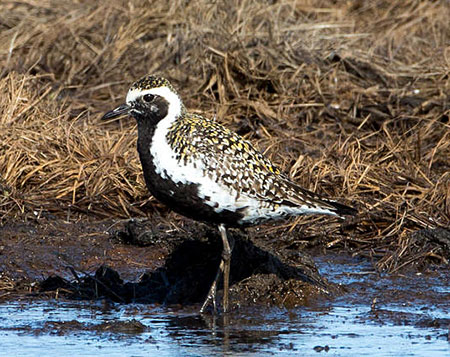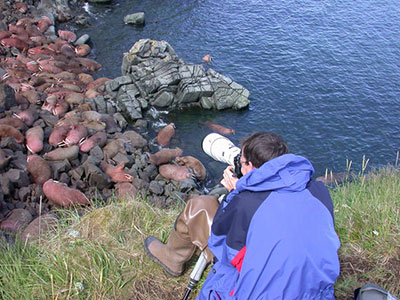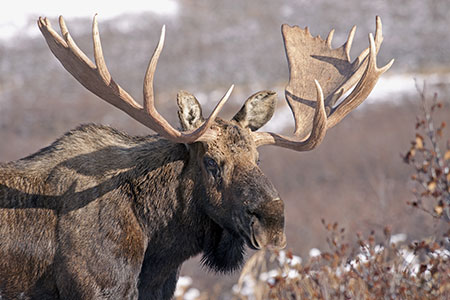Alaska Fish & Wildlife News
April 2019
The View From Alaska’s Wild Side

“One touch of nature makes the whole world kin.” —William Shakespeare
The surf charges in with a drumroll that crescendos, peaks, then breaks in a carbonated hiss. It’s late afternoon and, wrapped in waders and raingear, I’ve left my rented shack for the sand dunes of a lonesome Gulf Coast beach. The idea is to hike inland across the dunes, against a steady rain, and into the wetlands beyond to explore and witness a rare natural wonder.
Overhead, the skies swarm and clamor with northbound birds. Huge flocks move across a wilderness tapestry far from roads, electricity or Internet. This passage – of shorebirds and waterfowl by the millions – is what I’ve come to see. They storm the region late each April and May in a mass migration witnessed by relatively few, the sights and sounds a sensation worthy of any wildlife viewer’s bucket list.
Indeed, a desire to see wild creatures living as they have since the last ice age draws viewers to Alaska from all corners of the world. The state’s ranges, coasts and forests are famous for unique collections of birds and animals ranging from two-pound willow ptarmigan to two-ton Pacific walrus along with caribou, brown bear and so much more. Of course, the adventure is in the searching and the finding, the becoming a part of the place, its mountain backdrops and tundra plains, to find iconic musk ox, Dall sheep, moose – and even little birds as they pass in hordes across untamed skies.
Wet, wild and lonesome, Alaska’s Gulf Coast is a country of ocean squalls and glacier-hung mountains, a place where the winds sometimes howl for weeks without pause. Yet breaks in the weather occur, and when they do, this little known, largely uninhabited stretch of shoreline spanning some 200 miles between Cordova and Yakutat reveals itself as a world of contrasts. On days when sunshine floods land and sea, the hemlocks dry out and the hills glow in an enchanted light.
Harebells and salmonberries bloom purple and hot pink, and creatures – some large and lanky as 1,000-pound moose; others tiny and delicate as rufous hummingbirds, lighter than a nickel – appear in the marshes, thickets and at beach edges.
The rivers and streams here (there are many) serve as avenues for salmon: awesome runs of sockeye, Chinook and coho. And one particular river – the great, glacial Copper – has over the eons cut a deep, wide valley that each spring provides passage into Alaska’s Interior for multitudes of migrating waterfowl, shorebirds, songbirds, and raptors.
At the moment, I’m east of the Copper on a late-April day, dropped off by a bush plane chartered from Cordova, near a delta where two smaller rivers merge. The birds are here, as expected, resting in the marshes and flooding the skies en route to that ancient gateway to the Interior and Arctic nesting grounds. Not far from my shack, a shelter for commercial fishermen who appear for a few weeks each August to net late-summer coho, the dunes bordering the open coast end abruptly at a brackish, mile-long lake backed by an expansive bog. The lake is shallow and seems crossable, so I wade in and start sloshing my way across.

Shorebirds sail by in unimaginable numbers; some five to seven million of them will pass through before all is said and done, many just in from faraway places such as Mexico, Central America, and South America. Western sandpipers, plovers, dowitchers and dunlins whistle around me in whirling flocks, twisting and turning in single-minded masses. Sandhill cranes meander overhead, circling and gliding, their croaking, cracking calls distinctive as the spring season itself. Tundra swans honk and geese of all kinds cry out as they pass overhead in broad, northbound wedges.
At the bog, an organic brew of tannic water and decomposing plants, the air smells like rotten eggs. My pace slows to a tentative, mud-bottomed slog, and I’m startled as waves of pintails, wigeons, shovelers and teal in flocks of hundreds burst suddenly from the sedges.
A confession: I am a casual birder. While serious colleagues enjoy keeping life lists or collecting and recording sightings—endeavors that are interesting and potentially helpful to the overall study of birds—my approach is less structured, though no less passionate. Instead of recording lists or tallies, I like to view birds as living art forms, natural elements that fill critical niches in a broad, breathing canvas. I watch them, savoring their distinctive colors, movements and songs, then move on to the next piece of the canvas.
In that sense I’m less a birder, perhaps, than a student of nature in its entirety. And that’s fine. There are as many ways and reasons to view birds and wildlife as there are people interested in doing so. Even better, there are no hard, fast rules that apply to how nature is interpreted or enjoyed.
An hour later I’m beyond the bog, walking in a driven drizzle among tussocks and grass to my armpits. Steller’s jays with cobalt tails melding like winter nights into black, crested heads scream in the brush at the bog’s edge. Nearby, on the far side of a thicket, a river whispers.
The wide-open bog vanishes in a tangled, twisted forest of alders 10 feet tall and for a moment I sense a twinge of hopelessness. Engulfed in alders, I follow the sound of the current, tripping over trunks, cursing, then pushing on. And suddenly, the river appears. At its edge, bear tracks stamped into the mud meander upstream toward a forested valley. The gentle current simmers in the rain and I’m instantly aware that the dripping jungle around me is alive with peeping songbirds: juncos, sparrows, kinglets, and so many nondescript little brown warblers and whistlers that I can’t keep track of them all. I’m tempted to just sit there, watching, thinking and resting. But it’s getting late, and I must turn back.

Four days after my arrival, long enough to hear the cries of geese echoing in my head even when I sleep, I’m in the shack, warm and dry. I’m standing at the window, sipping hot cocoa, examining my reflection. The sun has broken out and the clouds have lifted revealing beyond the marsh a massive glacier framed by the jagged Coastal Range. Birds continue to whirl in flocks outside and in my mind where images of this trip will remain, I suppose, forever.
Suddenly, a dash of iridescent emerald appears before me on glittering wings, hovering at collar level beyond the reflected image of my red chamois shirt. At that moment I hear my plane coming. The hummingbird vanishes.
Going Wild
To experience the spring shorebird and waterfowl migration in and around the Copper River delta – to hit it just right – is to witness an aerial stampede. Seeing so many birds, and so many varieties, can be remarkable, even life changing. Better, it’s only one example of Alaska’s many unique wildlife-viewing opportunities.
In the way that a locale and its inhabitants can set a place apart, Alaska is distinctive for its animals and birds – from giant brown bears of Pleistocene dimensions to diminutive boreal chickadees – and for its backdrops of mountains, rivers, forests and tundra so deep and broad that the land seems to roll on forever. In fact, with 586,412 square miles of land mass (that’s more than a million acres or 1,600 square miles for every day of the year) the state is unfathomably huge, spanning an assortment of climate zones, geographies and ecosystems, each featuring its own distinctive collection of birds and animals.
Such variety in a seemingly endless wilderness can be intimidating to prospective wildlife viewers. But it needn’t be prohibitive. Simply focus on the bird or animal species you wish to see, and then determine through a bit of research just when and where in the state you’ll need to go find them. From there it’s a matter of sorting through logistics, including travel, food, and accommodations; aligning costs to suit your budget; and considering how much time you have to spend.

Going wild – striking out on your own or in a small group to search for wildlife in far-flung places—is one option. Dream venues await in every corner of the state: Consider Round Island in Southwest Alaska, where Pacific walrus may be seen hauling out on the beach by the thousands (for an instant preview, see them live via Web cam at explore.org/walrus); or Southeast’s Anan Creek in July and August when black bears and brown bears mingle to fish for pink salmon; the Arctic out of Nome, where you might rent a car to tour the road system and search for musk oxen or maybe connect with a local birding tour to find rare and colorful bluethroats and Arctic warblers.
Access to the more exotic places usually means taking a commercial jet from Juneau, Anchorage or Fairbanks to a hub city such as Petersburg, Wrangell, Cordova, Dillingham, or Kotzebue, among others. From there, passage into the wilderness might require a Bush plane or a boat charter off the coast or up a remote river. Do-it-yourself trips are possible and can ease expenses, but treks far from civilization require meticulous planning, and wilderness camping is not for the inexperienced. The cost of a guided tour is usually money well spent—these may include extended hikes or river floats through storied places such as the Brooks Range or the Arctic National Wildlife Refuge, where seasoned professionals handle logistics and safety.
Moose Madness
Armed only with a camera and with nowhere to hide I knew calling in a bull moose might be risky. But afternoon glare had eased into golden evening light and the willow shadows now stretched far uphill, highlighting subtle mountainside contours. Backed by the crags of the Chugach Range, alpine flora ablaze in the reds, oranges and yellows of fall, the setting and conditions were perfect for wildlife photography.
The only thing missing was a moose.
So I cupped my hands around my mouth and, in the eons-old tradition of northern hunters everywhere, began imitating a bull-moose challenge with a series of low, bellowing grunts. Moose tracks and trails were stomped into alpine tundra around me, and bark scraped from several head-high alders marked where bulls had rubbed velvet from their antlers. They were around.
The last time I’d successfully called in a moose I’d barely escaped up a spruce tree before a red-eyed, antler-thrashing bull charged out of the brush, furious and ready to fight. I’d stayed in that tree for a good, long time while the bull circled below, grunting and slobbering.
That close call had occurred years earlier, and I’d since tried many times under safer conditions to call bulls, but with no luck at all. Now, on that mid-September evening in Chugach State Park overlooking the city of Anchorage, the likelihood that I might make a moose appear seemed remote. Still, it was worth a try.

I hadn’t finished calling when alders started snapping violently in the gully below. Snatching my tripod and camera, I was preparing to bolt when a bull burst out only 30 yards away. Head low and glowering, it looked straight at me. The nearest tree was a half-mile away, and I realized the best I could do was stand stock-still and appear as unthreatening as possible. I didn’t even breathe.
Then, from the gully’s far side, came the sounds of more brush breaking. The bull turned its head just as a second bull stepped into the open. A distraction! For a moment it seemed I might escape, but then the first bull turned and, with steely resolve, started toward me.
I don’t know what I would have done had the bull kept coming. I’d run out of options. Fortunately, the second bull refused to be ignored and charged across the gully. The first bull braced to face its attacker and heads-down the two collided with a loud, hollow clacking of antlers. I seized the moment and high-tailed it for a nearby ridge, away from the heart of the action, but close enough to calm down and safely take pictures with my telephoto lens.
Finding untamed places and wild creatures in Alaska can be as simple and inexpensive as stepping outside or taking a drive. Even in Anchorage, a city of 300,000, it’s easy to find and view moose in Chugach State Park where bulls gather in September to knock heads and win breeding rights to harems of cows. Calling them in, of course, is unnecessary – and not advised.
Anchorage isn’t alone in its supply of urban wildlife-viewing opportunities. Every city, village and community in this wilderness state has its own birds, animals and viewing treasures. The key to finding them is to step outside, use some imagination, and be alert. In other words, consider yourself on safari. And no matter where in the state you may seek wildlife to photograph or view, keep in mind that your best days will include everything – the seasons, the weather, even subtleties of light falling early in the morning or receding with night’s advance. Work to see that each outing includes the calls of songbirds, the sounds of rivers, the touch of winds, and shadows cast by mountains and clouds. Do that and wherever in Alaska you look, you’ll find what you seek.
Ken Marsh is a public information officer for the Division of Wildlife Conservation and a longtime Alaskan who makes his home in Anchorage.
Subscribe to be notified about new issues
Receive a monthly notice about new issues and articles.
